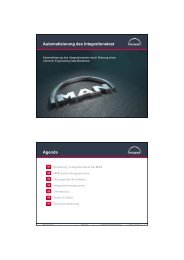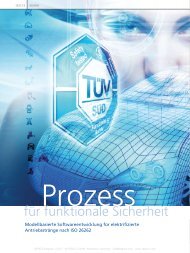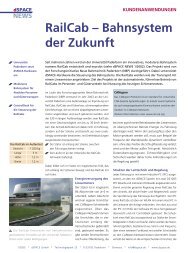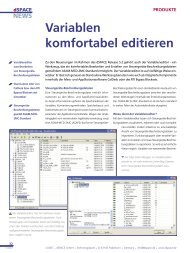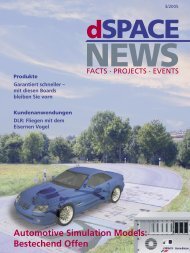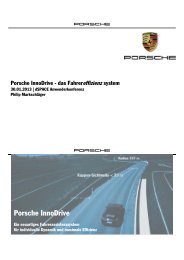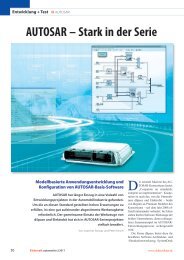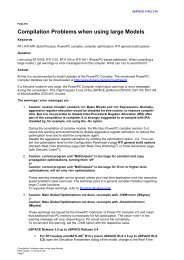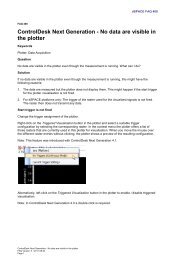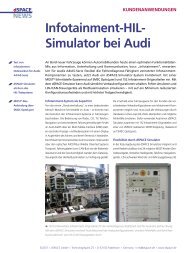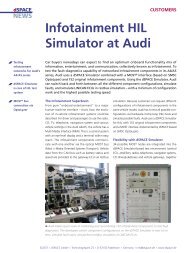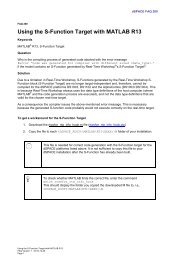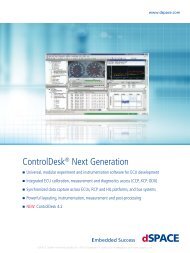magazinE - dSPACE
magazinE - dSPACE
magazinE - dSPACE
You also want an ePaper? Increase the reach of your titles
YUMPU automatically turns print PDFs into web optimized ePapers that Google loves.
And a Japanese company was<br />
experimenting with active noise canceling<br />
in windows for new housing<br />
construction. This is understandable,<br />
considering that in Tokyo, the highways<br />
run just a few meters away<br />
from people’s livingroom windows.<br />
What was your greatest challenge?<br />
In the starting phase, it was having<br />
enough staying power in the second<br />
year, when things progressed more<br />
slowly than the business plan said<br />
they would. The costs went according<br />
to schedule, the sales didn’t.<br />
That’s not unusual, as costs are simply<br />
easier to plan for. But selling the<br />
necessary numbers of a completely<br />
new kind of toolset for very special<br />
applications just takes time. This<br />
aspect is frequently underestimated.<br />
The greatest challenge of the past<br />
few years was when we had to get a<br />
whole Japanese subsidiary up and<br />
running in almost no time. With no<br />
prior warning and for reasons that<br />
were beyond our control.<br />
What was your biggest success?<br />
Convincing The MathWorks to<br />
cooperate with us to give Simulink,<br />
which was just being developed<br />
then, a realtime extension. There<br />
were only 6 people at <strong>dSPACE</strong> then.<br />
The MathWorks was already ten<br />
times as big and had never entered<br />
into a cooperation like that before.<br />
In the end, the project was a really<br />
important key to success for both<br />
companies.<br />
1. 2. 3. 4.<br />
What events and developments are<br />
you particularly pleased with?<br />
The best thing is that we have been<br />
growing organically for so long<br />
now and have always been able to<br />
stick to our core competencies.<br />
The context has changed repeatedly.<br />
Competitors appeared on the<br />
horizon and, luckily, some of them<br />
disappeared again. Focuses have<br />
shifted. New but related fields were<br />
added. I’ve also heard this from<br />
customers: it’s our continuity that is<br />
admired.<br />
1. <strong>dSPACE</strong>’s four founding members. From<br />
left to right: Dr. Herbert Hanselmann,<br />
Albert Schwarte, Dr. Hermann<br />
Henrichfreise and Andreas Hostmann.<br />
2. <strong>dSPACE</strong> started out on the second floor<br />
of this building on January 2, 1988. Step<br />
by step the company expanded to fill the<br />
basement and the attic, until it moved<br />
into its own building on January 2, 1995.<br />
3. Components of <strong>dSPACE</strong>’s first HIL<br />
simulator (fixed-point processor). The<br />
photograph was taken in the customer’s<br />
laboratory (Fatec) in 1989.<br />
4. In the early 1990s, the basement was the<br />
hardware laboratory for performing tests.<br />
“ An engineer without the ambition to deliver<br />
the best work possible that he or she can be<br />
proud of is not really an engineer.”<br />
Dr. Herbert Hanselmann<br />
The first turn-key HIL simulator in 1995. A cable from the simulator (multiprocessor system<br />
based on the TMS320C40 DSP, Tesis model) goes from an upstairs window down to the car<br />
to test its ABS and electronic differential. The workflow: Sit in the car, start the engine,<br />
drive off (in stationary mode) and brake to activate the ABS. The Audi 8 was on loan, so it<br />
had to be chained up.<br />
pAGe 51



